How to properly trim adenium?

Adenium surprises not only with its beautiful flowering, but also with a rather exotic stem root or caudex, which usually hides underground and retains nutrients and moisture. The important points of growing a succulent are competent pruning and transplanting of the plant, which are carried out in stages and in different ways.
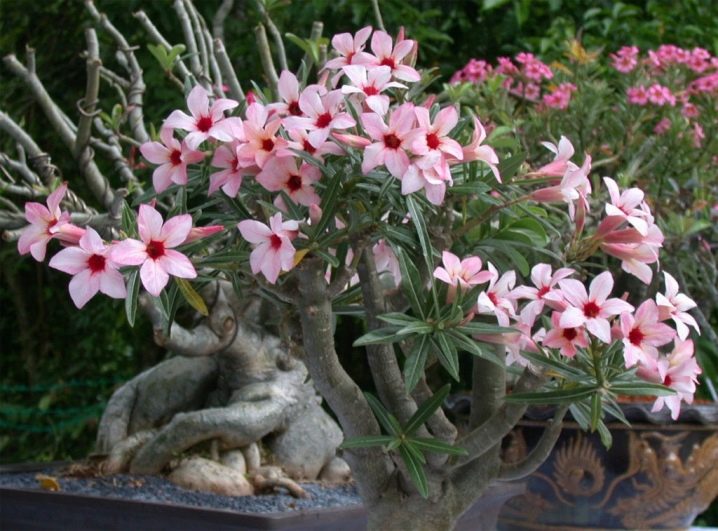
Is it necessary to trim the adenium?
With scissors, you can not only remove the dried parts of the plant, but also form the plant. Pruning the aerial part involves the removal of any part of the branch or the entire shoot, which will cause accelerated growth of the succulent, provoke bud formation and vigorous flowering.
Although adenium is a fairly hardy plant that firmly tolerates pruning not only of the aerial part, but also of the roots, it is necessary to take into account some features.
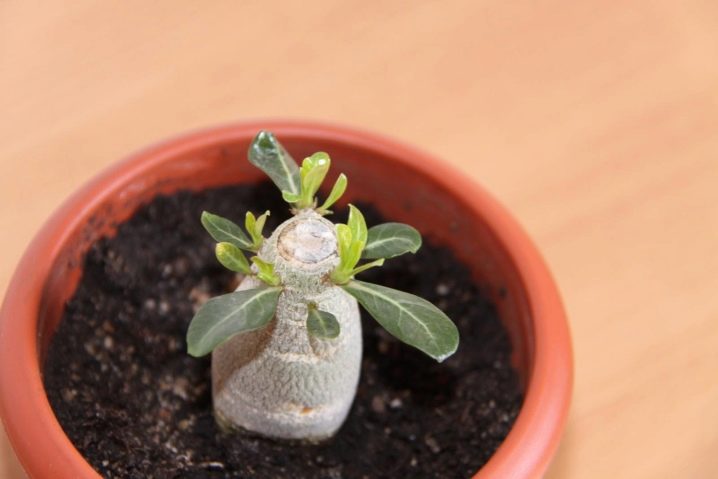
When is it better not to do it?
It is worth adhering to the following recommendations from specialists:
- do not expose a young immature plant to pruning and shaping; experts recommend waiting a while for a sufficient root mass to grow;
- you cannot cut off the branches of adenium in winter, when the plant is in hibernation, all its restorative forces are reduced, the growth of lateral shoots is suspended; if you cut off the top, the plant will stop developing or may die altogether;
- after the transplant, on which the succulent has already spent part of the effort, you must wait at least 3 weeks for the adaptation period to pass, only after that you can prune;
- cutting off a blooming adenium is not the right decision, since doing this is not only a pity, but also harmful;
- if the succulent was grown from seeds, special attention should be paid to the formation of the crown; for this, pinching of the apical part of the plant is performed, and so that the branches do not stretch out, it is necessary to shorten the branches by two-thirds every 2 years, which will certainly lead to swelling and growth of lateral shoots.

Formation step by step
For the production of work at home, it is necessary to prepare such tools and materials as:
- sharp instrument;
- cotton pads or napkins;
- rubber gloves;
- special balm or blocking paste;
- pruner or sharpened knife.

Crowns
When forming a crown, you need to pay attention to the following nuances:
- work is recommended to be carried out in protective gloves, which will not only protect against the poisonous sap of the plant, but also create sterile conditions for the process;
- when cutting off an adult plant, it is necessary to find a dormant bud growing on the outside of the branch;
- a correctly made cut should be half a centimeter higher than such a kidney;
- before pruning, it is necessary to present the grown branch, since it will change the entire image of the adenium, and also to assess all the risks;
- you should not leave twisted or growing inside the plant branches of the crown of the plant;
- in the presence of weak shoots, do not feel sorry for them and nurture them, they will still dry out; timely pruning will help form a gorgeous crown, provoke new side shoots and branching;
- the juice flowing down the plant leaves unsightly marks; to prevent stains, you must immediately remove them with a napkin or cotton pad;
- when the shoot is removed, juice begins to stand out abundantly, gradually its amount decreases, and then stops altogether, it is worth purchasing a special agent or balm in advance, which is sold in a flower shop, because it acts like a garden varnish - it is used to close the cut and prevent expiration, which will help not only to avoid messy footprints, but also keep moisture in the plant;
- do not throw away the trimmed part of the trunk - the stalk takes root easily;
- if the slices of the second and next order are observed in progression, you can provoke the adenium to start branching and create an exceptional crown.

Caudex
Caudex requires special attention from the grower.
You can begin to form an unusual caudex already in a young plant, which is barely more than 3 months old.
This process is carried out in several stages and is combined with transplanting and pruning branches. There are ways to create caudex, such as:
- trimming the central root, in which the lateral roots are actively growing; if you additionally cut off all the roots growing downward, you get a caudex shape, which is called an octopus;
- a method is widely known in which the caudex is not cut off, but various landing techniques are used; with each transplant, the root is slightly pulled out above ground level, thereby achieving an interesting effect of a bare root;
- possible planting of adenium on a disc or stone;
- you can gradually fold the softened caudex, creating a ring from the stem, or weave several trunks into a pigtail or an intricate knot.

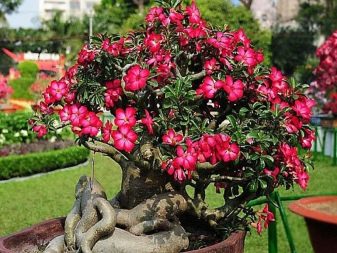

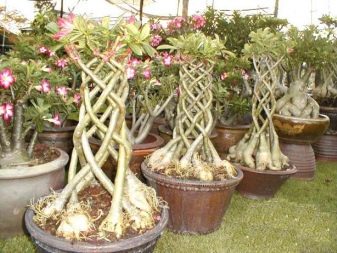
Another interesting technique is combining two or more young shoots. It is done as follows:
- young seedlings are interconnected and fixed with foil;
- in this form, they are placed in a moistened earthen substrate and placed in a warm, lighted place;
- sprayed periodically; watering is limited - once every 5-7 days, do not moisten the soil too much;
- after 1–1.5 months, it is worth removing the film to assess the condition of the pet;
- in places of close contact, it is necessary to make shallow cuts and reconnect the trunks with a film;
- the succulent is again placed in the substrate for about a month, during which the plant has time not only to grow roots, but also grow together with each other.
Care
For all its exoticism, adenium in daily care does not differ much from most indoor plants. The main rule in caring for any plant is love and attention, you need to look closely at the flower, try to understand its needs, take into account the peculiarities of caring for succulents. It is necessary to protect the flower from the cold of the windowsill, low temperatures, drafts, excess water.
Lighting is one of the main factors for a beautiful adenium. In the summertime, diffused light on the southern or southeastern windowsill is desirable.
Florists argue that it must be exposed for several hours in the summer under direct sunlight, which will provoke the laying of a huge number of buds and provide a gorgeous flowering.
It is advisable to expose the flower for the summer on a sunny balcony or veranda. In winter, it is necessary to provide additional lighting for at least 14 hours. With a lack of light, adenium will suffer, shed its leaves, and stop blooming.
It is also necessary to observe the temperature regime and humidity in the room. The higher the room temperature, the higher the humidity should be. Water containers left near the plant will help. Spraying the plant must be carried out very carefully, avoiding contact with the leaves and flowers of adenium, otherwise ugly spots will appear when the water and the sun interact. On long winter days, the plant suffers not only from short daylight hours and a drop in temperature, but also from excessive watering.
Experienced flower growers recommend reducing watering to 1 time per week in the autumn-winter period.
If it is cool in the apartment, you can, without much risk, skip watering altogether, replacing it by spraying the surface of the earth with warm, settled water.

Possible problems
The longitudinal wrinkles that have appeared on the trunk of the adenium are not a problem in themselves, since they can occur due to natural forces: in winter, during dormancy, when all the vital forces of the plant are used up, or in summer, in the heat due to lack of water. These wrinkles disappear over time as the adenium fills with moisture. In this case, it is enough to create conditions for the restoration of trunk turgor: timely watering and spraying of caudex.
But this can also be a harbinger of the death of a plant, if it is accompanied by the appearance of single yellow leaves, crumbling one after another, over and over again. Or, perhaps, with a healthy lush crown of adenium, when the caudex suddenly becomes soft to the touch, loses its elasticity and firmness.

To make sure that your pet is not suffering, you need to check the condition of the trunk by slightly cutting the top layer of the trunk.
If, instead of a light tissue, a dark one is found under the skin, then the caudex suffers from decay. When a brown liquid flows out when pressed, the matter is very bad, and the adenium dies. Caudex rot can occur with the onset of cool autumn weather, when night temperatures drop markedly and watering remains the same. Cold, damp ground can provoke the appearance of inflammatory diseases of the trunk and root.

There is no need to despair. It is much easier for an adult plant to cope with possible putrefactive manifestations. It is enough to arrange a grandiose drying of the succulent, of course, observing its condition. It is necessary to wait until the earthen coma is completely dry, generally eliminating watering and spraying. Even at the height of the heating season, it is allowed to install adenium closer to the radiator.
After drying, they take the plant out of the pot along with a dry clod of earth, shake it off or wash the roots, while it is possible that the rot can be easily removed from the healthy roots of the plant. If the business has taken on a more serious turn and in this way it was not possible to get rid of rot on the roots, it is necessary to cut the stem root to healthy tissue, after which it is transplanted into a new moist soil with a high perlite content.

If a young plant has rotted, it must be removed from the pot, rinsed from the damp substrate and carefully examined the problem areas. It's good if you can limit yourself to just removing rotten roots. If the putrefactive process has affected the caudex, you will have to cut off the damaged part. You need to cut it off carefully, with thin plastics, to healthy tissue. Such a peeled stem must be dried for 20-24 hours. After drying, the adenium should have a clean, dry stem.
If rot appears again, you will have to repeat the whole operation again.

Rooting
A succulent stalk after pruning or treatment for rot is easily rooted. For planting, only adenium with a dried caudex cut is used. And you will also need a pot of a suitable size, prepared earthen mixture and a little perlite. The soil should be moist, but not wet. Such a seedling is placed in a pot filled with a substrate.
The dish with adenium must be placed in a warm place - this is a prerequisite for rooting. The temperature should not be lower than +20 degrees.
To avoid the appearance of rot, you do not need to water, only spray, taking into account the temperature and humidity in the room.
Rooting takes place within a month, by this time the adenium releases new leaves and roots, after which you can transplant the succulent into a larger pot. Now that it has become a full-fledged plant with roots and leaves, more frequent watering is required - 1 time in 3-5 days.

Beautiful examples
Desert flowers or an unknown forest thicket will look very stylish in any interior. It's easy to do - just plant young seedlings in one flat bowl.A few months after the transplant, you need to pinch at the same height. After a year, it is necessary to slightly raise the roots of the succulent above ground level.

Arabian adenium is grown and used as a bonsai - this is due to the peculiarities of this plant species, which has a long dormant period. The plant blooms in spring, then drops flowers and plunges into pronounced hibernation;

An interesting form of succulent will cause constant interest and surprise even during the rest period. This look is achieved by clever tricks of connecting several caudexes when landing.
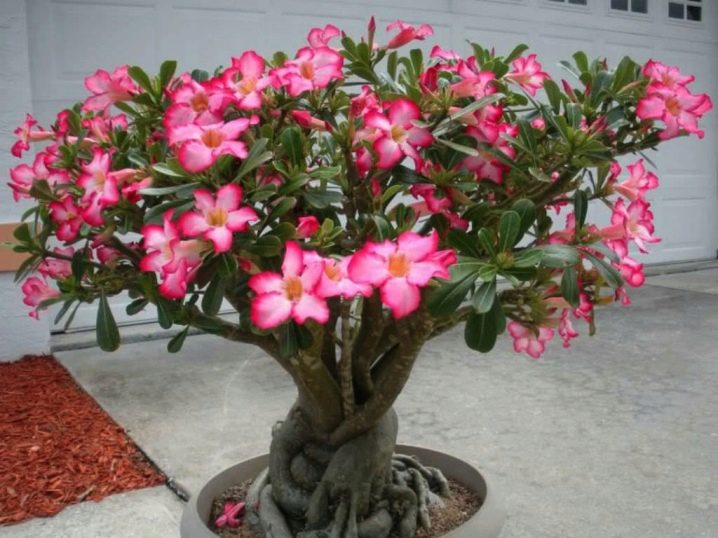
Adenium multiflorous has a lush crown with fleshy dense leaves and bright double inflorescences. The diameter of the flowers usually does not exceed 5 cm, rarely reaches 8 cm.
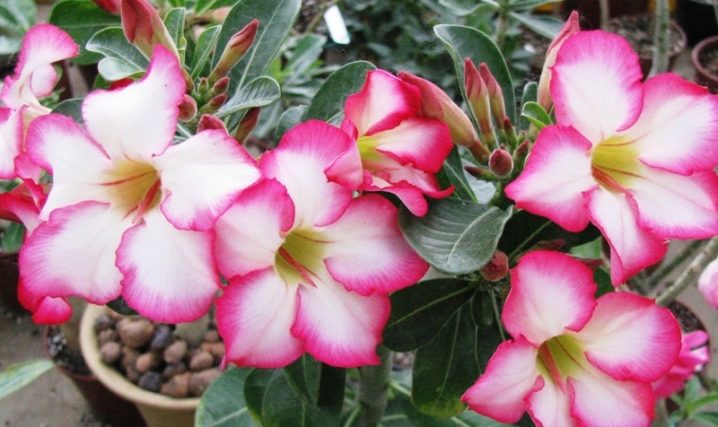
Adenium flowers come in various colors: white, yellow, red, almost black. Their diversity is surprising and fascinating. The combination of amazing blooms and unusual caudex makes adenium a favorite.



















































The comment was sent successfully.